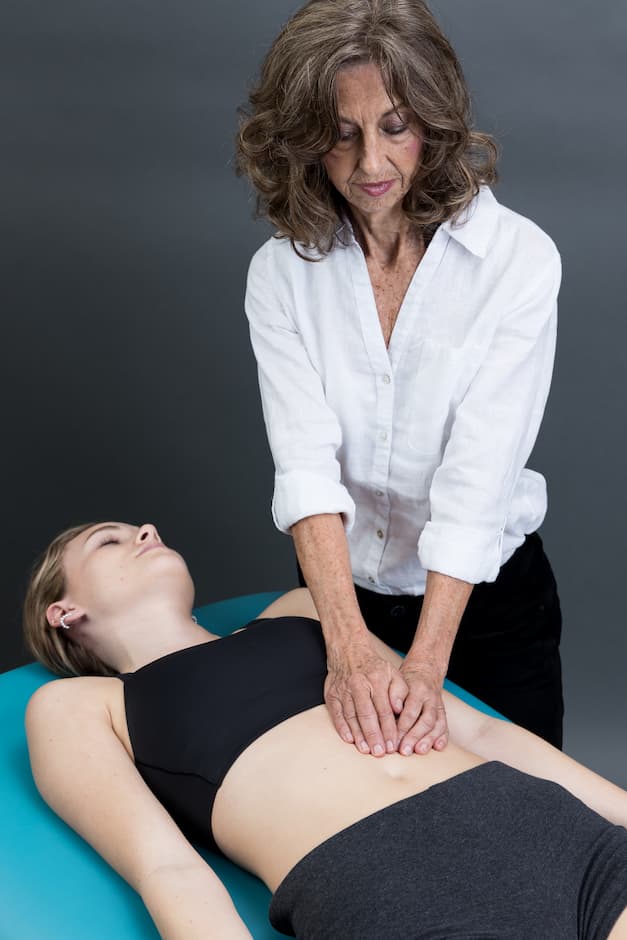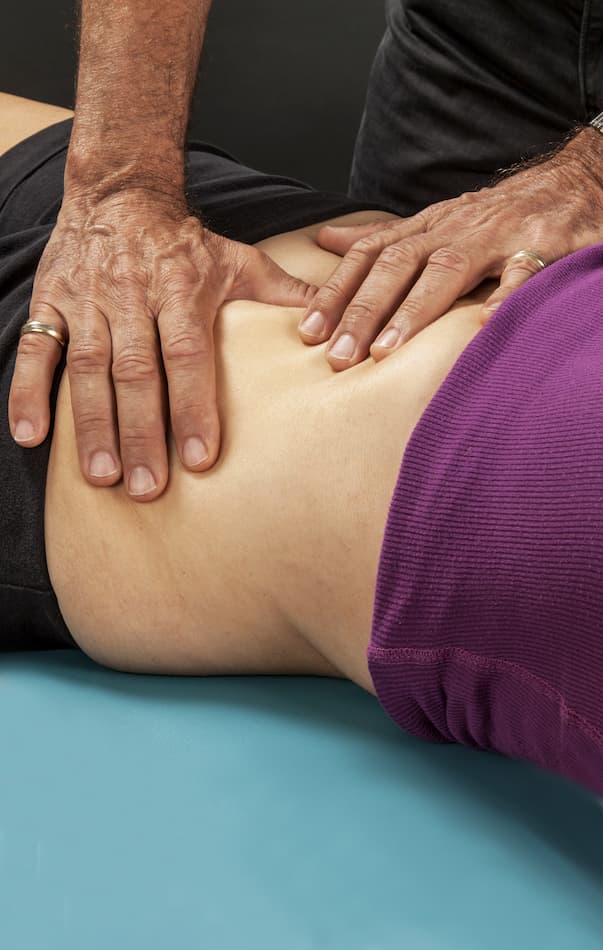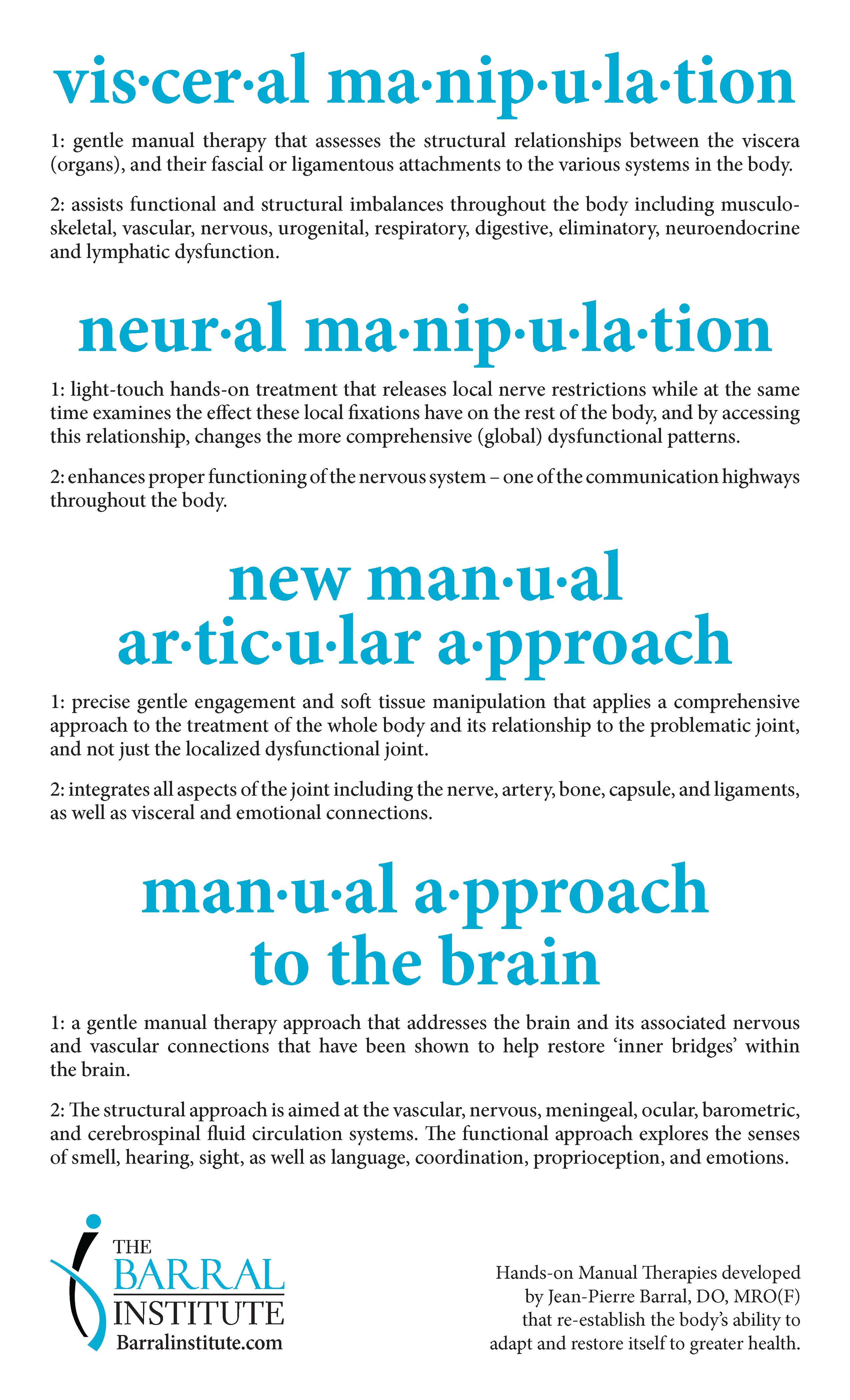
Barral's clinical work with the viscera led to his development of a form of manual therapy that focuses on the internal organs, their environment, and the potential influence on many structural and physiological dysfunctions. The term he coined for this therapy was Visceral Manipulation (VM). The purpose of VM is to re-create, harmonize, and increase proprioceptive communication in the body to enhance its internal mechanism for better health, thereby revitalizing a person, and relieving symptoms of pain, dysfunction, and poor posture. Visceral Manipulation treats a person's functional and structural imbalances with an aim to affect their musculoskeletal, vascular, nervous, urogenital, respiratory, digestive, and lymphatic dysfunction.
Jean-Pierre Barral's famous dictum, “Only the tissues know,” expresses that the tissues in the body have a deep and innate intelligence. Everything that has happened in our lives—injuries, diseases, stressors, etc.—is recorded in our tissues. At the core of Visceral Manipulation (VM) is 'listening' to the tissues with our hands. Through manual listening techniques, trained hands of a skilled practitioner feel where the tissues are pulling toward the areas of restriction, the areas where the body is not moving, and the areas of the greatest impact on the person's wellbeing from the manual therapy perspective.
Comparative studies found Visceral Manipulation beneficial for people with various conditions such as:
Acute Disorders
Neck Pain and Whiplash
Seatbelt Injuries
Chest or Abdominal Sports Injuries
Concussion
Traumatic Brain Injuries
Digestive Disorders
Bloating and Constipation
Nausea and Acid Reflux
GERD
Swallowing Dysfunctions
Women's and Men's Health Issues
Chronic Pelvic Pain
Endometriosis
Fibroids and Cysts
Dysmenorrhea
Bladder Incontinence
Prostate Dysfunction
Referred Testicular Pain
Effects of Menopause
Emotional Difficulties and Depression
Anxiety, Stress, Depression
Post-Traumatic Stress Disorder
Orthopedic Problems
Somatic-Visceral Interactions
Scoliosis
Chronic Pain
Motor-Coordination Impairments
Headaches and Migraines
Fibromyalgia and other Connective Tissue Disorders
Carpal Tunnel Syndrome
Peripheral Joint Pain
Sciatica
Sports Injuries
Pain Related to
Post-Surgical Dysfunction
Post-infection Scar Tissue
Autonomic Mechanisms
Pediatric Issues
Constipation and Gastritis
Persistent Vomiting
Vesicoureteral Reflux
Infant Colic
Learning Differences, ADD, ADHD

An integrative approach to evaluation and treatment of a patient requires assessment of the structural relationships between the viscera, and their fascial or ligamentous attachments to the musculoskeletal system. Strains in the connective tissue of the viscera can result from surgical scars, adhesions, illness, posture or injury. Tension patterns form through the fascial network deep within the body, creating a cascade of effects far from their sources for which the body will have to compensate. This creates fixed, abnormal points of tension that the body must move around, and this chronic irritation gives way to functional and structural problems.
Visceral Manipulation is organ-specific fascial mobilization and is based on the premise that free movement within the body is vital, and thus any restriction will adversely affect health. It evaluates and treats the dynamics of motion and suspension in relation to organs, membranes, fascia, and ligaments. Visceral Manipulation relies on the palpation of normal and abnormal forces within the body, with the specific goal of encouraging normal tone and movements, both within and between the internal organs, their connective tissue, and other structures of the body where normal motion has been impaired. By using precise manual techniques, such as palpation of the superficial and deep fascia and the mobility and motility of individual organs, therapists can evaluate how abnormal forces interplay, overlap, and affect the normal body forces at work. The goal of Visceral Manipulation is to help the person's body return to normal function and thereby remove compensatory symptoms, whatever their source, leading to improved health and optimal body functioning.

Frequently Asked Questions
Visceral Manipulation is used to locate and solve problems throughout the body. It encourages the body’s own natural mechanisms to improve the functioning of organs, dissipate the negative effects of stress, enhance mobility of the musculoskeletal system through the connective tissue attachments, and influence general metabolism. If various tissues are restricted or organs are unable to move properly because of an injury, illness, accident, etc., then they do not function optimally.
For instance, the force of a seatbelt during a collision can cause restrictions of the tissues around a person’s liver. In this case, the liver is not able to move normally, and the function of the liver can decrease. Also, the liver attachments—diaphragm, rib cage, spine, stomach, kidneys, etc.—are adversely affected. The person might begin to feel pain and stiffness in their neck, right shoulder, ribcage, spine, as well as experience low energy and poor digestion. By addressing the tissue restrictions around the liver with VM, which is the source of the cascade of symptoms, the person will begin to function optimally again.
Our body is made up of many interrelated components such as bones, muscles, nerves, and fascia, as well as the internal organs (viscera). Your organs are in perpetual motion. When you breathe, walk, and stretch, your organs move in your chest and abdomen. For example, when you take a breath, your kidneys move one inch; and with deep inhalation, they move 4 inches. In a day, they move a little over 1/2 mile. That’s around 19,000 miles a lifetime!
This movement of organs is transmitted through fascia to other structures of the body. When you are healthy, all structures move with an interconnected fluidity. All this movement is important as it influences activities throughout the body from the tiniest cellular pulsations to rhythmic contractions of the heart and blood flow. Optimum health relies on a harmonious relationship between the motions of the organs and other structures of the body.
There are many reasons for an organ to lose its mobility such as physical traumas, surgeries, sedentary lifestyle, infections, pollution, bad diet, poor posture, and pregnancy/delivery. When an organ is no longer freely mobile but is fixed to another structure, the body is forced to compensate. This disharmony creates fixed, abnormal points of tension and the chronic irritation gives way to functional and structural problems throughout the body—musculoskeletal, vascular, nervous, urinary, respiratory and digestive, to name a few.
Imagine scar tissue around the lungs. Because of the pull of the adhesion, with every breath, the movement patterns of the nearby structures would be altered. This could shift rib motion creating pulls on the spine. These restrictions might then show up as mid-back and neck pain, as well as limited motion in the shoulder. This scenario highlights just one of hundreds of possible ramifications of a small dysfunction —magnified by thousands of repetitions each day. This also explains how pain can often be far removed from the actual cause.
There are definite links between somatic structures, such as the muscles and joints, the sympathetic nervous system, the visceral organs, the spinal cord, and the brain. For example, the sinuvertebral nerves innervate the intervertebral disks and have direct connections with the sympathetic nervous system, which innervates the visceral organs. The sinuvertebral nerves and sympathetic nervous system are linked to the spinal cord, which has connections with the brain. In this way someone with chronic pain can have irritations and facilitated areas not only in the musculoskeletal system (including joints, muscles, fascia, and disks) but also the visceral organs and their connective tissues (including the liver, stomach, gallbladder, intestines and adrenal glands), the peripheral nervous system, the sympathetic nervous system and even the spinal cord and brain.
Barral Manual Therapies look at the whole person. During the evaluation process, after restrictions or areas of immobility are identified, the related tissues released through precise treatment. The type of treatment depends upon where the restrictions are found. For example, if the liver is restricted, the treatment would include VM. If the sciatic nerve is restricted, then Neural Manipulation would be a focus. And if the carotid artery is restricted, the treatment would involve Visceral Vascular Manipulation. This is why Jean-Pierre Barral has developed integrative manual therapies that work together to support the overall well-being of a person.
At the core of the pain or diagnosis is a compensatory pattern created in the body with the initial source of the dysfunction often being far from where the pain is felt. Because of this, the practitioner searches for this pattern and the source, and treats the related tissues to encourage the normal mobility, tone and motion of the viscera and their connective tissues. The treatment is a gentle compression, mobilization, and elongation of the soft tissues. As the source of the problem is released, the symptoms may start to decrease, and there may be an improvement in the functioning of individual organs, the systems the organs function within, and the structural integrity of the entire body.
Due to the delicate and often highly reactive nature of the visceral tissues, gentle force precisely directed reaps the greatest results. As with other methods of manipulation that affect the body deeply, VM works only to assist the forces already at work. Because of that, trained therapists can be sure of benefiting the body rather than adding further injury or disorganization. Harmony and health exist when motion is free and excursion is full - when motion is not labored, overexcited, depressed, or conflicting with neighboring structures and their mobility.
Learn the facts about Barral Institute Therapies. Discover our Manual Therapy Techniques and their benefits. This flyer is informative for therapists and clients.
This is not an exhaustive list of contraindications. We trust that each practitioner will study the work further to understand indications and contraindications in relation to working with clients with Visceral Manipulation.
There are very few contraindications overall for Visceral Manipulation. Some of those contraindications include infection, inflammation, and signs of recent trauma. There are contraindications for certain VM techniques when working with certain populations, such as a pregnant client or an infant.
To find a Therapist, visit iahp.com

Definition Poster
Available for free downloading and printing!
- Excellent visual for your clinic,
- Share in your enewsletters for your clients.
- Flyer to pass out.
Share the jpg file on your Facebook page to help spread the word!
Contact Us
Ready to learn about becoming a certified Barral practitioner?
Contact us today to get started.


































































